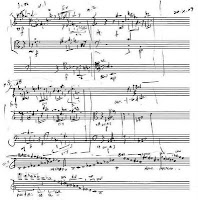
[ click for larger image ]
Most of this page has sketches from the beginning of the score; but I worked on material for the “hazy chorale” on the bottom two staves.
I began work on this passage by constructing the chord . . . wanted a rich (but ‘gauzy’) chord for (mostly high) winds. Hearkening back to work on my doctoral dissertation (Uncondyssion’d Ayres), I decided to construct it as a ‘spiral’ of interval classes (1,2,1,2,3,2,3,[4…]) . . . thus on the penultimate staff, from the bottom: B [interval class 1] C [i.c. 2] D [i.c. 1] E-flat [i.c. 2] F [i.c. 3] A-flat [i.c. 2] B-flat [i.c. 3] D-flat.
A spontaneously whimsical (maybe) decision was to make the full chord a mirror of itself; so on that same staff, working downwards from above the staff: D [i.c. 1] C# [i.c. 2] B [i.c. 1] A# [i.c. 2] G# [i.c. 3] F(-natural) [i.c. 2] E-flat [i.c. 3] C.
‘By ear’ I thought I should prefer some other pitch content, so further to the right on that staff are two transpositions of the top ‘octachord’, first up a minor third from the D, and then up a further major second to G, which produced the 16-note chord which I want.

[ click for larger image ]
On this scrap, I jotted down the rhythmic pattern of reiterations of the notes of the chord; the result (in this application) is a subtle pattern of “glowing” pulses. I had decided on a five-measure stretch, so the first line ‘states the obvious’ in breaking those measures down into component sixteenth-notes. My concern was simply with a pattern which does not fit within the regularity of the 4/4 meter. On the third line I dispense with the plus signs as taking up space I require for other purposes . . . as with the construction of the chord, I decided to apply a ‘mirror’ to the rhythmic values. Thus, the durations ‘radiate’ from the underscored ‘3’ . . . after the retrograde, though, I ‘build’ the pattern by accretion, in adding the underscored ‘1’, &c.
The second line as a parallel pattern, a free-ish spin-off of the first; and below I have assigned eight winds each to the two patterns.

[ click for larger image ]
This is the application, in rhythmic notation, of the two rows of figures in the page before; together with indications of which instruments to repeat their pitches where.

[ click for larger image ]
Around the actual compositional work, I draw up little ‘grocery lists’ like this, as a peg on which to hang musical ideas for ready reference later. The pages above are one application of what I’ve written about mid-page as ‘I. non-homorhythmic “chorale” in winds’.

[ click for larger image ]
And this is the ‘realization’ on MS. of all the non-notational scribblings of the top three sheets.
Discreet Erasures ticker: [current data not available] 12:00 AM Friday, 23 October
1 comment:
This is yet another opportunity to regret my lack of application to childhood music lessons; it woul dbe great if I could actually read music! Your process (in this instance, at any rate) seems similar to how I'd approach composition, if only I could approach it at all...!
Post a Comment